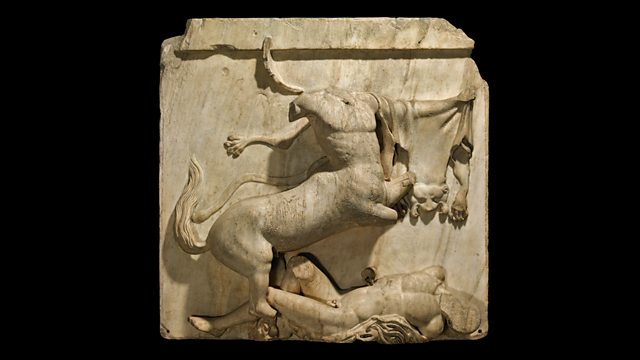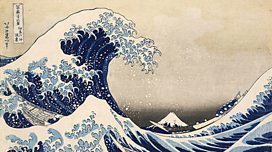Parthenon Sculpture: Centaur + Lapith
Neil MacGregor's history of humanity through objects at the British Museum arrives at the Parthenon in Greece and the story of the great sculpture
Neil MacGregor's telling of the story of humanity through individual objects at the British Museum. This week he is looking at the emergence of powerful new forces across the globe around the 5th Century BC, from Confucius in China to Cyrus in Persia.
Today he looks at the emotionally charged sculptures that were made for the Parthenon in Athens. Carved out of marble around 440BC these beautiful figures continue to generate huge controversy around the world for the fact that they remain in London and have not been returned to Greece. In today's programme the British Museum's director acknowledges the political controversy of the Elgin Marbles (named after the British Lord who carried them off) but concentrates on their artistic story and on exploring the ancient Greek world that created them. He describes a culture besotted with the myths and imagery of battle. The Greek archaeologist Olga Palagia and the classicist Mary Beard help conjure up the extraordinary city of antiquity.
Last on
![]()
Discover more programmes from A History of the World in 100 Objects about art.
About this object
Location: Athens, Greece
Culture: Ancient Greece
Period: About 447-432 BC
Material: Stone
��
This sculpture from the Parthenon shows a Centaur rearing triumphantly over a dying human Lapith. This focus on human suffering epitomises the intense humanism of Greek art. The sculpture also represents Greece's struggle to resist being absorbed into the Persian Empire. The Greeks had a strong notion of their own identity and regarded the Persians as barbarians like the Centaurs. The Parthenon was completed in 432 BC on the site of an earlier unfinished temple destroyed by the Persians.
What was the legacy of Classical Greece?
Victory over the Persians in 479 BC inspired a period of great creativity in Athens. This was the time of the philosopher Socrates, the playwright Sophocles and the statesmen Pericles. The wealth from Athens' Mediterranean empire funded the building of the Parthenon - an architectural testament to Athenian supremacy. Although Athens' golden age lasted for less than a century it was hugely influential. Greek ideas in drama, philosophy, literature, art, science and maths would dominate European thought for the next two millennia.
Did you know?
- The word barbarian comes from the Greek word for non-Greeks
Living with the Parthenon Sculptures
By Ian Jenkins, Curator, British Museum
��
I visit the Parthenon galleries on most working days and never grow tired of their timeless beauty and breathing vitality.
During public hours, the galleries are always crowded, as people gather from all over the world to see one of the great highlights of the Museum’s permanent collection. I say permanent, but that does not mean that the display remains always the same. The Museum is constantly researching the sculptures and looking for new ways of promoting understanding of them.
In this ‘laboratory of Parthenon studies’ there has been much excitement lately about the detection of ancient blue pigment on some of the sculptures.
Such discoveries are always shared first with Parthenon enthusiasts around the world and not least with colleagues in Greece. The Museum enjoys good relations with the Greek Archaeological Service, and both sides are determined not to let the politics of the campaign for the restitution of the sculptures get in the way of our friendship which is based upon mutual respect.
Since the late 1970s, I have followed with interest the great programme of restoration of the Acropolis monuments. This excellent project is correcting the mistakes of previous restoration and has been removing the sculptures that had remained on the building. Lord Elgin’s earlier act of rescue saved the sculptures in the British Museum from damage and loss through weathering. A comparison of plaster casts of the West frieze made in 1802 shows just how much the sculpture has deteriorated. The original sculpture was removed from the building in 1993.
Lord Elgin did more than physically save the sculptures. Once removed from the building they took on a life of their own. No longer seen as architectural ornament or antiquarian curiosity, they also became icons of western art.
In the British Museum they are both admired for their intrinsic beauty and they play a vital role in the Museum’s great story of human civilisation throughout the world, past and present.
New technology, ancient colour
By Giovanni Verri, Scientist, British Museum
��
We know that the architectural parts of the Parthenon were once painted because obvious traces of the colours still remain on some of them. However, archaeologists and art historians have always assumed that the sculptures themselves were also once painted.
Until 2008 no one had ever been able to prove this, despite many attempts over almost 200 years. Many people (including the famous nineteenth century scientist Michael Faraday, a pioneer in electricity and magnetism) examined the pieces for colour, but nobody found anything convincing.
Now, thanks to a new imaging technique developed by scientists at the British Museum, we have clear evidence of the presence of ancient blue paint on these sculptures.
The blue found (known as Egyptian blue) is perhaps the earliest pigment made by man rather than being produced by grinding naturally occurring rocks. It is a quite difficult pigment to form; it is made by mixing sand, chalk, copper and a material like Natron—the salt used for mummification—and by heating this mixture to about 900?C for several hours. When out of the kiln, the resulting cake of a deep blue material is ground up and used as a pigment.
Egyptian blue was a very important colour in the ancient world. It was first developed in Egypt and Mesopotamia in around 2500 BC. With time it spread throughout the Mediterranean world and the Assyrians, Greeks and Romans used it in great quantities. The secret of how to make it was lost after the decline of the Roman Empire, and it was replaced by natural pigments such as lapis lazuli, azurite and indigo.
The paint on the Parthenon has been very difficult to find because only microscopic and discoloured specks survive. However even these can now be easily identified by using the new imaging technique.
To do this, it is necessary to shine red light on the surface of the object in a darkened room. If Egyptian blue is present, the particles will absorb the red light and emit infrared light that can be recorded using an infrared-sensitive camera, producing pictures where any blue areas seem to glow white. Since all that is required is the use of a red light, the sculptures are not harmed or even touched.
The exceptionally strong infrared emission from Egyptian blue that causes it to ‘glow in the dark’ is related to its molecular structure and allows it to be differentiated from other ancient pigments. The discovery of Egyptian blue on the Parthenon suggests that traces of less easily detected remnants of other colours may also still remain on the sculptures. Hopefully, one day similar techniques to look for other ‘hidden’ pigments will be discovered and the Parthenon sculptures will ‘glow with many colours’.
Transcript
Broadcasts
- Tue 23 Feb 2010 09:45����ý Radio 4 FM
- Tue 23 Feb 2010 19:45����ý Radio 4
- Wed 24 Feb 2010 00:30����ý Radio 4
- Tue 25 Aug 2020 13:45����ý Radio 4 FM
Featured in...
![]()
Art—A History of the World in 100 Objects
A History of the World in 100 Objects - objects related to Art.
Podcast
-
![]()
A History of the World in 100 Objects
Director of the British Museum, Neil MacGregor, retells humanity's history through objects





